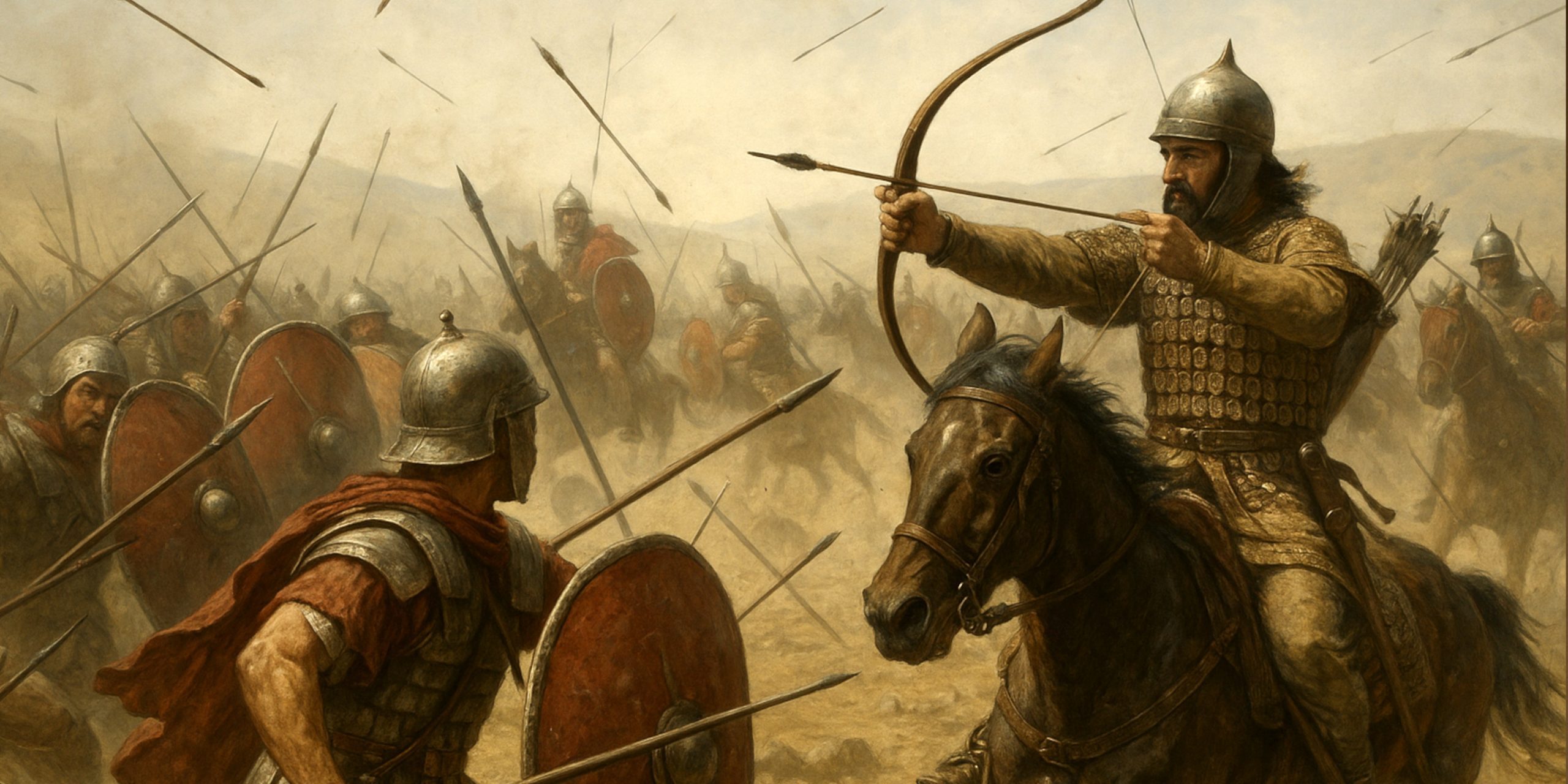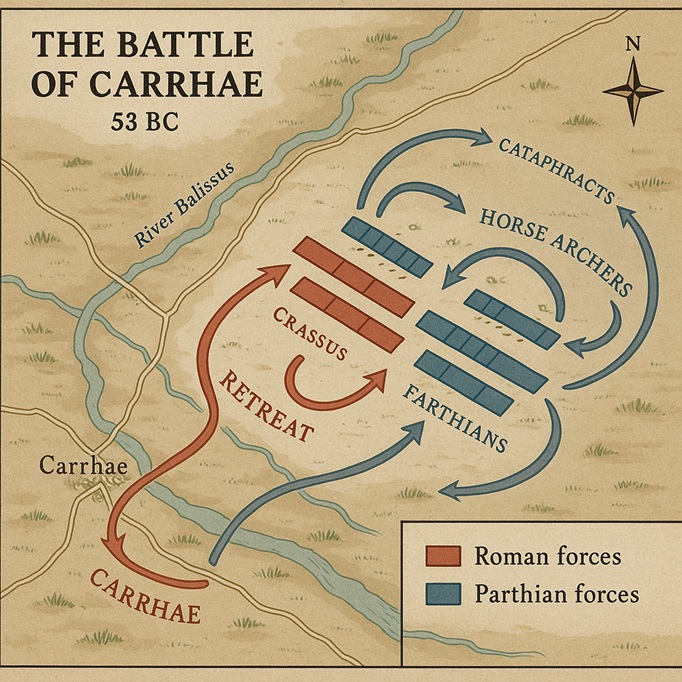
The Battle of Carrhae, fought in 53 BC, was one of Rome’s most devastating defeats against the Parthian Empire. It pitted the Roman Triumvir Marcus Licinius Crassus against the Parthian general Surena in the arid plains of Mesopotamia. This clash not only ended Rome’s eastward expansion for a generation but also demonstrated the effectiveness of Parthian cavalry warfare against the Roman legions.
Background
Crassus, famed for his role in suppressing the Spartacus revolt and his immense wealth, sought military glory to rival that of Julius Caesar and Pompey. His invasion of Parthia, launched without Senate approval, was driven by ambition and the lure of eastern riches. The Parthians, under King Orodes II, entrusted the defence of their western frontier to their noble general Surena.
Forces
Leaders
| Side | Commander | Notes on Leadership |
|---|---|---|
| Rome | Marcus Licinius Crassus | Experienced politician and general but lacking in eastern campaign expertise |
| Parthia | Surena | Skilled cavalry commander, politically astute, and from one of the richest noble families in Parthia |
Troop Composition
| Side | Estimated Strength | Composition |
|---|---|---|
| Rome | c. 35,000–40,000 | 7 legions of heavy infantry, allied cavalry (c. 4,000), light infantry, and archers |
| Parthia | c. 10,000–12,000 | Around 9,000 horse archers and 1,000 heavily armoured cataphracts |
Arms and Armour
Roman Forces
- Infantry: Lorica hamata (chainmail), scutum shields, gladii, pila (javelins)
- Cavalry: Light armour or none, small shields, spears
- Archers: Limited in number, using simple wooden bows
Parthian Forces
- Horse Archers: Composite bows with high draw strength, light lamellar or scale armour, rapid hit-and-run tactics
- Cataphracts: Full lamellar armour for rider and horse, long kontos lances, heavy shields
| Unit Type | Primary Weapon | Armour Type |
|---|---|---|
| Roman Legionary | Gladius, pilum | Chainmail, scutum |
| Roman Cavalry | Spear, sword | Light leather or mail |
| Parthian Horse Archer | Composite bow | Light scale or lamellar |
| Parthian Cataphract | Kontos lance | Full lamellar for rider and mount |
The Battle

Crassus marched into Mesopotamia and chose to cross near Carrhae, ignoring advice to move along the Euphrates where water and supply lines were plentiful. Surena lured the Romans into open desert terrain ideal for cavalry manoeuvres. Using a constant barrage of arrows and feigned retreats, the Parthian horse archers kept the Romans under relentless pressure, replenishing arrows from a supply train of camels. The Roman heavy infantry, unable to close the distance, suffered mounting casualties. The final blow came when the Parthian cataphracts charged exhausted Roman lines.
Crassus’s son, Publius, led a counterattack with cavalry but was surrounded and killed. Roman morale collapsed. Crassus attempted negotiations but was killed in the ensuing chaos, with Roman losses estimated at over 20,000 dead and 10,000 taken prisoner.
Archaeology
- Excavations near modern Harran have uncovered traces of ancient fortifications that may have been used during the Roman retreat.
- Parthian composite bow arrowheads have been found in the region, supporting accounts of the scale of archery fire.
- Numismatic evidence from the period, including Parthian coinage depicting mounted archers, aligns with descriptions of Surena’s army.
Battle Timeline
| Date | Event |
|---|---|
| Early 53 BC | Crassus launches invasion from Syria |
| Spring 53 BC | Roman forces enter Mesopotamia and advance towards Carrhae |
| Late Spring 53 BC | Surena engages Romans on open plains; continuous arrow fire begins |
| Battle Day | Publius leads cavalry counterattack, is surrounded and killed |
| Aftermath | Crassus killed during failed parley; survivors retreat in disorder |
Contemporary Quotes
Plutarch on Surena’s strategy:
“He seemed to be vanquished in flight, but in truth he was leading on his pursuers into destruction.”
Cassius Dio on Roman losses:
“Never had so great a force, so renowned and so strong, perished in one battle.”
Plutarch on Crassus’s fate:
“Thus ended Crassus, the richest of the Romans, meeting his death through his insatiable lust for wealth.”
Legacy
The defeat at Carrhae marked a turning point in Roman eastern ambitions. Parthia proved itself a match for Rome, and the tactics of mounted archers and armoured cavalry would influence military thinking for centuries. For Rome, the loss was a humiliation, damaging the prestige of the Triumvirate and contributing to the instability that would lead to civil war.
Watch the documentary:



